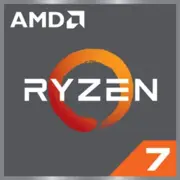AMD Ryzen 7 8700G

The AMD Ryzen 7 8700G processor is a powerful and efficient CPU that is perfect for desktop usage. With a total of 8 cores and 16 threads, this processor can handle even the most demanding tasks with ease. The 7 nm technology ensures that it operates at an optimal level while maintaining a manageable thermal output of 65W.
The base frequency of 4.2 GHz and a max turbo frequency of 5.1 GHz means that this processor delivers exceptional performance, making it suitable for both gaming and heavy-duty tasks such as video editing and rendering. The large 16MB L3 cache also ensures that data can be quickly accessed, further enhancing the processor's overall speed and efficiency.
One of the standout features of the Ryzen 7 8700G is its integrated graphics model, which provides excellent visual performance without the need for a separate graphics card. This makes it an attractive option for those looking to build a powerful yet cost-effective desktop setup.
Overall, the AMD Ryzen 7 8700G processor offers a winning combination of high performance, efficiency, and affordability, making it an excellent choice for anyone in need of a top-tier desktop CPU.
Basic
Label Name
AMD
Platform
Desktop
Launch Date
January 2024
Model Name
?
The Intel processor number is just one of several factors - along with processor brand, system configurations, and system-level benchmarks - to be considered when choosing the right processor for your computing needs.
Ryzen 7 8700G
Code Name
Zen 4 (Phoenix)
CPU Specifications
Total Cores
?
Cores is a hardware term that describes the number of independent central processing units in a single computing component (die or chip).
8
Total Threads
?
Where applicable, Intel® Hyper-Threading Technology is only available on Performance-cores.
16
Performance-cores
8
Performance-core Base Frequency
4.2 GHz
Performance-core Max Turbo Frequency
?
Maximum P-core turbo frequency derived from Intel® Turbo Boost Technology.
5.1 GHz
L1 Cache
64K per core
L2 Cache
512K per core
L3 Cache
16MB shared
CPU Socket
?
The socket is the component that provides the mechanical and electrical connections between the processor and motherboard.
AM5
Technology
?
Lithography refers to the semiconductor technology used to manufacture an integrated circuit, and is reported in nanometer (nm), indicative of the size of features built on the semiconductor.
7 nm
TDP
65 W
Max. Operating Temperature
?
Junction Temperature is the maximum temperature allowed at the processor die.
95 °C
Memory Specifications
Memory Type
?
Intel® processors come in four different types: Single Channel, Dual Channel, Triple Channel, and Flex Mode. Maximum supported memory speed may be lower when populating multiple DIMMs per channel on products that support multiple memory channels.
DDR4-3200
Max Memory Size
?
Max memory size refers to the maximum memory capacity supported by the processor.
128GB
Memory Channels
?
The number of memory channels refers to the bandwidth operation for real world application.
2
GPU Specifications
Integrated Graphics Model
?
An integrated GPU refers to the graphics core that is integrated into the CPU processor. Leveraging the processor's powerful computational capabilities and intelligent power efficiency management, it delivers outstanding graphics performance and a smooth application experience at a lower power consumption.
True
Benchmarks
Geekbench 6
Single Core
Score
2664
Geekbench 6
Multi Core
Score
13895
Geekbench 5
Single Core
Score
2014
Geekbench 5
Multi Core
Score
13217
Passmark CPU
Single Core
Score
3929
Passmark CPU
Multi Core
Score
31587
Compared to Other CPU
Geekbench 6 Single Core
Geekbench 6 Multi Core
Geekbench 5 Single Core
Geekbench 5 Multi Core
Passmark CPU Single Core
Passmark CPU Multi Core
Share in social media
Or Link To Us
<a href="https://cputronic.com/cpu/amd-ryzen-7-8700g" target="_blank">AMD Ryzen 7 8700G</a>